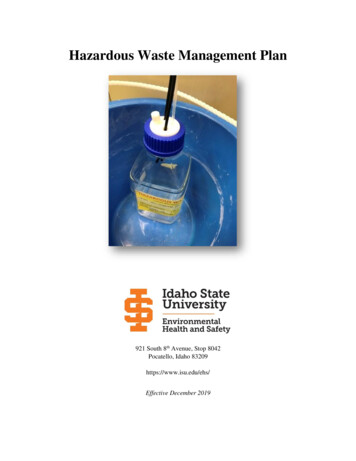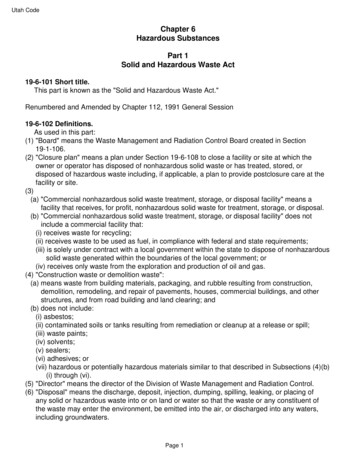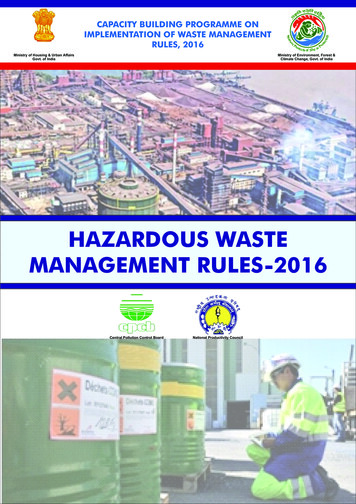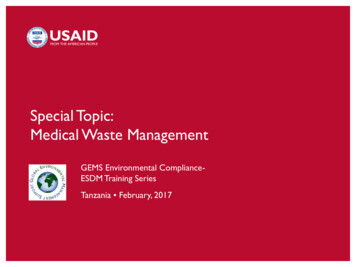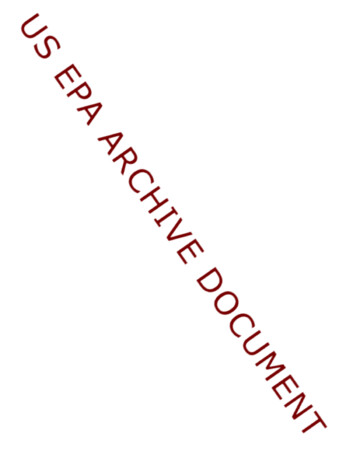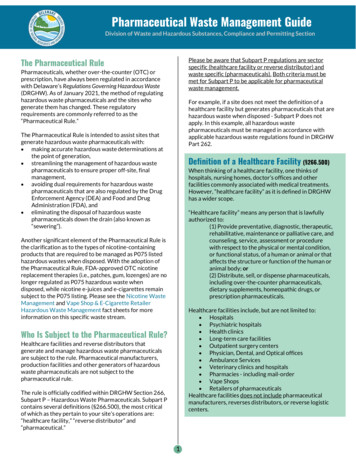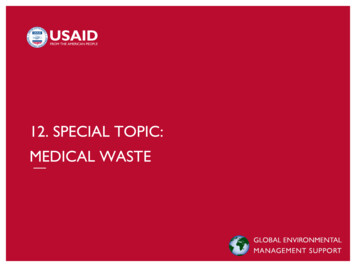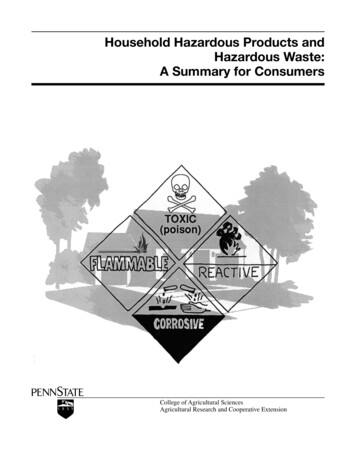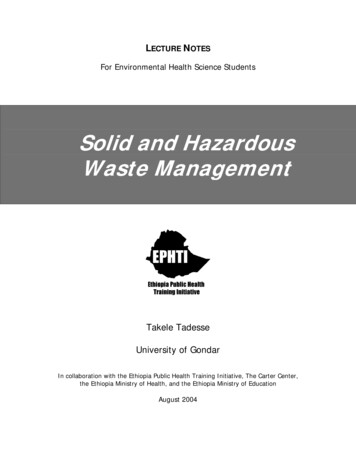
Transcription
LECTURE NOTESFor Environmental Health Science StudentsSolid and HazardousWaste ManagementTakele TadesseUniversity of GondarIn collaboration with the Ethiopia Public Health Training Initiative, The Carter Center,the Ethiopia Ministry of Health, and the Ethiopia Ministry of EducationAugust 2004
Funded under USAID Cooperative Agreement No. 663-A-00-00-0358-00.Produced in collaboration with the Ethiopia Public Health Training Initiative, The CarterCenter, the Ethiopia Ministry of Health, and the Ethiopia Ministry of Education.Important Guidelines for Printing and PhotocopyingLimited permission is granted free of charge to print or photocopy all pages of thispublication for educational, not-for-profit use by health care workers, students orfaculty. All copies must retain all author credits and copyright notices included in theoriginal document. Under no circumstances is it permissible to sell or distribute on acommercial basis, or to claim authorship of, copies of material reproduced from thispublication. 2004 by Takele TadesseAll rights reserved. Except as expressly provided above, no part of this publication maybe reproduced or transmitted in any form or by any means, electronic or mechanical,including photocopying, recording, or by any information storage and retrieval system,without written permission of the author or authors.This material is intended for educational use only by practicing health care workers orstudents and faculty in a health care field.
Solid Waste ManagementPrefaceInadequate or inappropriate management of solid wasteproduced in the course of human activities is likely to haveserious public health consequences and deleterious effects onthe environment.In this lecture note, the various categories of solid wastes aredefined. Considerable emphasis is given to classifications,generation rate and composition of solid waste. Most of thetext, however, is devoted to the functional elements of ,collection and disposal of solid wastes. The varioustechnologies for final disposal of solid wastes are discussed indetail.For health-care institutions in which resources are severelylimited, there is a separate premise on minimal programs; thissummarizes the simplest and least costly techniques that canbe employed for the safe management of health-care ealthprofessionals, and public health professionals with an temanagement system to minimize or eliminate public andi
Solid Waste Managementenvironmental health problems so as to prevent diseases andpromote health and well being of the community. Its scope issuch that it will find application in diploma and degreestudents alike. The lecture note has four chapters and each ofthe chapters has review questions at the end to enhance theteaching/learning process.ii
Solid Waste ManagementAcknowledgmentsI would be failing in my duty if I did not pay my thanks to thosewho have helped and encouraged me in writing this teachingmaterial.I am grateful to Professor Dennis G. Carlson, Advisor to orable advice. The author is highly thankful to The CarterCenter for its overall financial and material help from inceptionto completion of this teaching material.I gratefully acknowledge Ato Gabre-Emanuel Teka, AssociateProfessor in the Faculty of Medicine, Department ofCommunity Health, Addis Ababa University for givingthorough reading and valuable comments throughout all thechapters.I wish to express my sincere thanks to the following reviewerswhose contributions are reflected throughout this material: Dr.Mengesha Admassu, Ato Shiferaw Gezehagn, Ato MamoWubshet, Ato Gashaw Andargie, Ato Yifokir Tefera, and W/tAnsha Nega of Gondar University College, Ato Kebede Farisand Ato Gebi Kurkura of Jimma University.iii
Solid Waste ManagementI am indebted to Ato Aklilu Mulugetta, Business Manager andW/t Meseret Tsegaw, Office Manager, at The Carter Centerfor their unlimited support in the process of this teachingmaterial preparation.Lastly I would like to thank my wife S/r. Meseret Senbeto andmy child Abel Takele for their sustenance and patience duringthe writing of this lecture note.iv
Solid Waste ManagementTable of ContentsPrefaceiiAcknowledgementsivTable of ContentsviList of Tables and FiguresviiiCHAPTER ONE: SOLID WASTE MANAGEMENT11.1. Learning Objectives11.2. Introduction11.3. Types of Non-hazardous Solid Waste51.4. Sources of Solid Waste61.5. Public Health and Ecological Aspect8Review Questions10CHAPTER TWO: CLASSIFICATION, GENERATION11RATE AND COMPOSITION OF SOLID WASTES2.1. Learning Objectives112.2. Introduction112.3. Classification of Solid Waste122.4. Generation Rate of Solid Waste132.5. Composition of Solid Waste162.6. Quantities and Volume of Solid Waste18Review Questions19v
Solid Waste ManagementCHAPTER THREE: FUNCTIONAL ELEMENTS OF21SOLID WASTE MANAGEMENT PROGRAM3.1. Learning Objectives213.2. Introduction213.3. On Site Handling, Storage and Processing of Solid22Waste3.4. Collection of Solid Waste263.5. Transfer and Transport343.6. Resource Recovery and Processing353.7. Disposal of Solid Waste40Review Questions75CHAPTER FOUR: HAZARDOUS SOLID WASTES76MANAGEMENT4.1. Learning Objectives764.2. Introduction774.3. Concern about Hazardous Waste Management794.4. Characteristics of Hazardous Waste804.5. List of Hazardous Chemicals824.6. Transportation and Disposal of Hazardous Waste834.7. Control of Hazardous Waste854.8. Health-Care Institution Solid Waste88Review Questions105Glossary106References110vi
Solid Waste ManagementList of Tables and FiguresTable 1. Type of waste with respect to its length of8storage daysTable 2 Ordinary physical composition of municipal17solid wasteTable 3 Typical data on moisture content of18municipal solid wasteTable 4 The ideal size of compost pit for home and70institutionTable 5Risk of infection after hypodermic needle90punctureFigure 1 Typical garbage can with tightly fitting cover24Figure 2 The source and uses of recycled paper39Figure 3 Uncontrolled solid waste disposal44Figure 4 Single chambers on site incinerator49Figure 5. Salvaging by municipal refuse workers72Figure 6. Recommended protective clothing for101health care waste transportationvii
Solid Waste ManagementCHAPTER ONESOLID WASTE MANAGEMENT1.1Learning ObjectivesBy the end of this chapter, the students will be able to:1. define solid wastes.2. describe major sources of solid wastes3. list types of solid wastes.4. discuss public health importance of solid wastes5. mention ecological impacts of solid wastes1.2IntroductionSolid wastes are all the wastes arising from human andanimal activities that are normally solid and are discarded asuseless or unwanted. The term solid waste as used in this textis all- inclusive, encompassing the heterogeneous mass ofthrowaways from the urban community as well as the morehomogeneous accumulation of agricultural, industrial, ,discarded waste materials are often reusable and may beconsidered as a resource in another setting. Integrated solid1
Solid Waste Managementwaste management is the term applied to all of the activitiesassociated with the management of the community’s waste.The basic goal of integrated solid waste management is tomanage community waste in a manner that meets publichealth and environmental concerns and the public’s desire toreuse and recycle waste material.Solid waste today contains many materials such as plasticsthat are not readily degradable and toxic materials, primarilyvarious types of chemical waste produced by industry.Similarly, the amount of hazardous waste generated has beenundergoing dramatic change. In addition, industries increasetheir annual discharges of toxic chemicals directly into theenvironment.Early civilizations did not have a problem with waste becauseit consisted mainly of organic wastes and the decomposersconverted it into useful materials. There were also fewerpeople, and they generated little waste. The problem becamelarger with more people generating more and a variety ofwaste. (chemical, liquid, solid, nuclear, and hazardous). Littleof this waste is food for the decomposers. Thus, a variety ofmethods must be used to manage the waste.2
Solid Waste mencompasses sweeping, storage, collection, and disposal ofsolid waste. Proper management in these four areas helpsgreatly in controlling insects, rodents and filth borne diseases.In Ethiopia, particularly in Addis Ababa, an agency isresponsible for the collection and disposal of solid wastes forthe city of Addis Ababa with an estimated total population of2.9 million in 2000. The agency has a clear mandate from thecity administration of Addis Ababa. It has an institutionalsetup, separate budget, as well as the necessary equipment,manpower and logistics for the task. The activity is nowcarried out by 10 sub-city administration where a division runsthe solid waste management program. At present, the agencyhas 3000 employees in the street sweeping unit and parkdevelopment, and 128 permanent employees in the garbagecollection units. It had a fleet of 74 heavy-duty trucks, (about40 on the move) and two bulldozers and one compacter at thelandfill site.The estimated solid waste generation of an Addis Ababaresident was about 0.24 kilogram per capita per day and atotal of 163,200 tons per annum. The existing collectioncapacity covered less than 50 percent of the total wastesgenerated. The remaining wastes were dumped along thestreets, on vacant plots, along streams, in ditches, bridges,etc.3
Solid Waste ManagementSolid waste management in other urban centers of Ethiopiaare under the jurisdiction of Municipal Division of Health. Allmunicipalities (except Addis Ababa) and certified urbancenters are mandated by Proc. No. 206 of 1981 to provide,maintain and supervise environmental health services alongwith their other activities in their municipalities and urbancenters. Thus, solid wastes management services are theresponsibilities of these municipalities and urban centers.Most of them have no institutional set up and resources fordischarging their duties effectively. This is aggravated by thelow priority usually accorded to sanitation activities.The sanitarians assigned to the regional health departmentsand health centers give technical advice whenever called forbesides their routine activities.Therefore, the material that follows will discuss the majoraspects of solid waste management including type, source,and public health and ecological impacts of solid wastes.4
Solid Waste Management1.3Types of Non-Hazardous Solid WasteRefuse: Includes all solid wastes. In practice this categoryincludes garbage, rubbish, ashes, and other wastes.1. Garbage: designates putrescible wastes resulting fromthe growing, handling, preparation, cooking, and servingof food. It attracts insects, rats and rapidly decomposeswith production of unpleasant odor.2. Rubbish: This term includes all nonputrescible refuseexcept ashes. There are two categories of rubbish:combustible and noncombustible.a. Combustible: This material is primarily organic innature and includes items such as paper, cardboard,wood and bedding.b. Noncombustible: This material is primarily inorganicand includes tin cans, metals, glass, ceramics, andother mineral refuse.3. Ashes: Waste products from coal, charcoal, and woodwhen burned.4. Other wastes: demolished materials, abandoned cars,andconstructionwastes,municipal waste.5arealsoconsideredas
Solid Waste Management1.4Sources of Solid WastesThe materials that are collected under the term solid wasteinclude many different substances from a multitude ofsources. The sources of solid wastes are dependent on thesocioeconomic and technological levels of a society. A smallrural community in Ethiopia may have known types of solidwaste from known sources. While a big city such as AddisAbaba may have many sources.Most people can identify solid waste when they empty theirtrashcans. There are much more household wastes that areconsidered to be solid waste than realized.In all cases the following sources are universal:1. ), generally contain non-hazardous solid wastes;kitchen waste, ‘‘Ketema”, and ash are common inEthiopia.2. Agricultural: solid wastes due to agricultural activities:food residues, animal dung, crop residues, etc. Suchwastes are usually non-hazardous and negligible in ruralEthiopia.3. ts: food establishments, shops, etc, that6
Solid Waste Managementgenerate generally non-hazardous waste such as paper,cardboard, wood, metals and plastic.4. Industrial wastes: from various types of industrialprocesses. The nature of the waste depends on the typeof industry and kind of raw material involved. There maybe toxic and hazardous wastes that have adverse effectsto the environment.5. Institutional solid waste: generating from public tes,schools, universities, etc.; generally not hazardous.6. Hospital solid wastes: discarded, unwanted solid wastesfrom hospitals. It consists of both non-hazardous andhazardous waste. The above classification helps toidentify whether the waste is hazardous or not.7
Solid Waste ManagementTable 1. Type of waste with respect to its length ofstorage daysWaste typeLength ofControl guide linestorage(minimum)daysGarbage4Fly breedingResidential rubbish7Flies, land pollutionMixed refuse4FliesStreet sweeping7UnsightlinessDead animals1Flies, animal diseasesSpecial waste1Human diseasesAshes14Feces1Air pollution,UnsightlinessFlies, human diseases1.5. Public Health and Ecological AspectsThe proper storage at the point of generation, collection anddisposal of the solid waste is part of the environmental healthservice program, which must be accomplished effectively in acommunity.1. They produce a good breeding place for flies, hencecreate a favorable conditions for food contamination byflies and other fly-borne diseases.8
Solid Waste Management2. Provide food and shelter for rats and mice, which aredestroyers and contaminants of food and other goods.3. Under certain conditions, may create suitable breedingplace for mosquitoes. Subsequently bring in the problemof mosquito-borne diseases, (e.g. malaria, filariasis, etc)4. May cause nuisances- which create aesthetic problem,(e.g. looks unpleasant and has bad smell, etc.)5. May attract dogs, cats and other scavengers.6. May cause fire hazards by instantaneous combustion.The public health and ecological reasons for propermanagement of solid wastes are:-an attractive media for the growth and multiplication offlies, and hence, may involve all diseases which senteries. etc);-a suitable breeding place for mosquitoes, subsequentlybringing the problem of mosquito-born diseases;-a good harborage for rats, which can be an economic aswell as health problem;-from aesthetic point of view , such as bad odor , unsightlyconditions etc;-pollution and contamination of air , land and water;-possible fire hazards by instantaneous combustion;9
Solid Waste ManagementReview Questions1. What is solid waste?2. Why is the problem of solid waste associated with time?3. What are the major sources of solid waste?4. What is the public health importance of solid waste?5. How can solid waste affect humans from an ecologicalperspective?10
Solid Waste ManagementCHAPTER TWOCLASSIFICATION, GENERATIONRATE AND COMPOSITION OFSOLID WASTE2.1. Learning ObjectivesBy the end of this chapter, the students will be able to:1. describe the major classifications of solid waste.2. define the terms "puterscible" and "non-putrescible" solidwaste.3. describe the advantages of determining the solid wastegeneration rate.4. list factors that determine the generation rate of solidwaste.5. determine the quantity and volume of solid wastes.6. explain the composition of solid wastes.2.2IntroductionThe characteristics, quantities, volume and composition ofsolid waste generated may differ from one country to another11
Solid Waste Managementand between urban and rural areas. It depends mainly uponthe customs, climate, living conditions and economic standardof the area.2.3. Classification of Solid WasteSolid waste can be classified into two categories by itscharacteristics. These are:A. Putrescible solid wasteB. Non-Putrescible solid waste.A. Putrescible wastes-Are solid wastes that can be easily decomposed bybacterial action-Result from the growing, handling, preparation, cookingand consumption of food.-Their quantities are varying throughout the year, beinggreatest in amount during the summer months whenvegetable wastes are more abundant.-Require careful handling with frequent removal andadequate disposal.-Are the most valuable component yielding fertilizers, orsoil conditioners, through composting processes and usedas animal/hog feed (e.g. garbage).12
Solid Waste ManagementB. Non putrescible wastes-Are solid wastes that cannot be easily decomposed bymicrobial ns,andpaper,non-combustiblebrush,glass,cardboard, wood, scrap metals, bedding, yard clippings,crockery, etc.-Are frequently responsible for the creation of nuisancesand esthetic problems when they become scattered bythe wind and careless handling (e.g. rubbish).2.4Generation Rate of Solid WasteDetermination of the generation rate of solid waste isimportant to obtain data in order to determine waste volumeand for subsequent solid waste management.Factors to consider for the purpose of determining thegeneration rate are:1. Measures of quantitiesa. Volume measurement.b. Weight measurementBe careful in volume measurement because you need todistinguish wastes which are compacted and loosened. Both13
Solid Waste Managementhave different weight and volume. Weight is the most accuratebasis for records regardless of whether the waste is loose orcompacted.2. Statistical AnalysisIt is necessary to have some statistical base for solid wastemanagement system development. This includes placementof containers, programming the collection program andallocation of vehicle type. (See chapter 3)3. Expression of Unit GenerationIn addition to knowing the source and composition of solidwaste, it is important to have uniform units of expression.a. Residential and Commercial – kilogram per capita per day(Kg/c/d)b. Agricultural –Kilogram per hectare per year (kg/ ha/ year)4. Methods Used to Determine Generation Ratea. Load count analysis –basically involves counting of theindividual loads over a specified time period. If possible,weighing the load will be very important.b.Weight -volume analysis- measuring the volume of thetruck and weight of each load will give ample data.14
Solid Waste ManagementAlthough the technique is expensive, it is used to: draw asystem boundary round the unit to be studied; identifywhat occurrences affect generation rates; identify the rateof generation associated with different activities using thedata available; determine the quantity of waste generated,stored and collected5. Typical Generation RateThis is the rate found by conducting a large survey veryrepresentative for a nation, state or locality.6. Factors Affecting Generation RatesFactors that affect the generation rate of solid waste include:a. geographical location – related primarily to the differentclimate that can influence both the amountand collection operation.b.season of the yearc.frequency of collectiond. characteristics of populatione. extent of salvage and recycling.f.legislationg. public attitude15generated
Solid Waste Management2.5. Composition of Solid WasteComposition of solid waste depends on the local factors suchas time of the year or season, habits of the community,educational status, economic status, geographical location,and population size.A. Physical CompositionKnowing the physical composition of solid waste is importantfor the selection and operation of equipment facilities, toassess the possibility or feasibility of energy recovery and todesign disposal facilities. Its analysis may contain individualcomponent study, moisture content study and density.16
Solid Waste ManagementTable 2. Ordinary physical composition of municipal solidwasteComponentPercent by 0-20.50-20121-474-1682-860-111-420-104Food rden trimmingWoodGlassTin cansNonferrous metalsFerrous metalsDirt, Ash, BrickSource: Rolf Eliassen et al: Solid Wastes EngineeringB. Chemical CompositionIt is very important to study the nature and value of solidwaste to plan different disposal and recovery options. Thesestudies include the assessment of moisture content, volatility,ash content, etc.The moisture content of municipal solidwastes varies depending on composition of the waste, theseason of the year, humidity and weather condition.17
Solid Waste ManagementTable 3. Typical data on moisture content of municipal solidwaste.ComponentMoisture content by percentRangeTypicalFood tiles6-1510Rubber1-42Leather8-1210Garden trimming30-8060Wood15-4020Glass1-42Tin cans2-43Nonferrous metals2-43Ferrous metals2-63Dirt, Ash, Brick, Stone6-128Source: Rolf Eliassen et al: Solid Wastes Engineering2.6Quantities and Volume of Solid WasteVarious estimates have been made on the quantity of solidwaste generated and collected per person per day. Theamount of municipal solid waste collected is estimated to be18
Solid Waste Management2.7 kg/capita/day, of which about 0.6 kg is residential.Averages are subject to adjustment depending on manyfactors: time of the year; habits, education, and economicstatus of the people; number and type of commercial industrialoperations; whether urban or rural area; and location.Each community should be studied and actual weighing madeto obtain representative information for design purposes.Community wastes are not expected to exceed 1000kg/capita/year. With the emphasis being placed on sourcereduction such as less packaging, waste recovery andrecycling such as of paper, metals, cans, and glass, theamount of solid waste requiring disposal is reduced. Thevolume occupied by solid waste under certain conditionsdetermines the number and size or type of refuse containers,collection vehicles, and transfer stations. Transportationsystems and land requirements for disposal are also affected.19
Solid Waste ManagementReview Questions1. What are the major classifications of solid wastes?2. What are the factors that determine the generation rate ofsolid waste?3. Why it is important to determine the generation rate ofsolid waste?4. How can you determine the composition of solid waste?5. What are factors that determine the generation rate ofsolid waste?20
Solid Waste ManagementCHAPTER THREEFUNCTIONAL ELEMENTS OF SOLIDWASTE MANAGEMENT SYSTEM3.1Learning ObjectivesBy the end of this chapter, the students will be able to:1. list functional elements of a solid waste managementprogram.2. identify requirements of solid waste storage containers.3. realize that collection process of solid wastes is complex.4. compare sanitary land fill and incinerators.5. identify common dead body disposal methods.6. describe common solid waste disposal methods.3.2IntroductionAesthetics, land use, health, water pollution, air pollution, andeconomic considerations make proper solid waste storage,collection and disposal of solid wastes (municipal discriminate dumping of solid waste and failure of thecollection system in a populated community would soon causemany health problems. Odors, flies, rats, roaches, crickets,21
Solid Waste Managementwandering dogs and cats, and fires would dispel anyremaining doubts of the importance of proper solid wastestorage, collection and disposal.3.3 On-Site Handling, Storage and Processingof Solid WasteA. On-Site HandlingOn-site handling methods and principles involve publicattitude and individual belief, and ultimately affects the publichealth. It is an activity associated with the handling of solidwaste until it is placed in the containers used for its storagebefore collection. This may take place at any time before,during or after storage.Importance of on-site handling of solid waste:-reduce volume of waste generated-alter physical form-recover usable materialsOn- site handling methods:-sorting-shredding-grinding-composting22
Solid Waste ManagementFactors that should be considered in evaluation of on siteprocessing include capabilities, reliability, environmentaleffects, ease of operation, etc.B. On- Site StorageThe first phase to manage solid waste is at home level. Itrequires temporary storage of refuse on the premises. Theindividual householder or businessman has responsibility foronsite storage of solid waste.For individual homes, industries, and other commercialcenters, proper on-site storage of solid waste is the beginningof disposal, because unkept or simple dumps are sources ofnuisance, flies, smells and other hazards.There are four factors that should be considered in the onsite storage of solid waste. These are the type of container tobe used, the location where the containers are to be kept,public health, and the collection method and time.1. Storage containersGarbage and refuse generated in kitchens and other workareas should be collected and stored in properly designed andconstructed water-proof garbage cans (waste bins). The cansor receptacles can be constructed from galvanized iron sheetor plastic materials. They should have tightly fitting covers.23
Solid Waste ManagementThey must be of such size that, when full, they can be liftedeasily by one man. They should be located in a cool place onplatforms at least 30 centimeters above ground level. Afterputting in garbage, they should be kept covered. The binsmust be emptied at least daily and maintained in cleanconditions. A typical example of garbage can, constructedfrom galvanized iron sheet, dimensions: diameter 45 cm andheight 75 cm, is shown in figure 1 below.An adequate number of suitable containers should beprovided with proper platforms with receptacles stand. Thenumber may depend on the amount, type and establishmentswhere the need arises. Suitable containers should be watertight, rust-resistant, with tight-fitting covers, fire-resistant,adequate in size, light in weight, with side handles andwashable.75 cm45cmFigure 1. Typical Garbage Can with Tightly Fitting CoverSource: Gabre-Emanuel Teka (1997): Solid Waste Disposal From FoodPremises; In Food Hygiene2445cm75 cm45cm45cm
Solid Waste Management2. Container Size (capacity)Consideration should be given for the size of the loadedcontainer that must be hauled to the collection vehicle or tothe disposal site.Therefore, container size for:-ash: up to 80 to 128 liters-mixed refuse: should not exceed 120 to 128 liters-rubbish up to 200 liters-kitchen waste is 40 liters-garbage is 48 to 80 litersPlastic liners for cans and wrapping for garbage reduce theneed for cleaning of cans and bulk containers, and keep downodors, rat and fly breeding.Galvanized metal is preferable for garbage storage because itis resistant to corrosion. Plastic cans are light in weight butare easily gnawed by rats.Bulk containers are recommended where large volumes ofrefuse are generated, such as at hotels, restaurants,apartment houses, and shopping centers.A concrete platform provided with a drain to an approvedsewer with a water faucet at the site facilitates cleaning.25
Solid Waste ManagementOn- site processingImportance of on-site processing:-reduces volume of waste generated-alters physical form-recovers usable materialsFactors that should be considered in evaluating on-siteprocessing are capabilities, reliability, environmental effects,ease of operation, etc.3.4Collection of Solid WasteThis is the removal of refuse from collection points to finaldisposal site. It is the most expensive as compared with otheroperation and management procedures, because it demandsspecial vehicles, experienced people to manage, moremanpower, hand tools, and more funds for fuel, salary,maintenance, gathering or picking up of solid waste from thevarious sources, taking the collected wastes to the locationwhere it is emptied, and unloading of the collection vehicle.Collection cost has been estimated to represent about 50% ofthe total cost of collection when a sanitary landfill is used asmeans of disposal, and 60% when incineration is used.Home collection of solid waste generally is done by a privatecollector or a local government-owned and financed operation.26
Solid Waste ManagementPrivate collectors usually charge a fee to each individualhomeowner, or a government contract will pay the fees. Thegovernment contract enables solid waste collection in auniform, sanitary manner. Without such a contract, someindividuals may be reluctant to pay the collector for the serviceand the refuse may go uncollected.1. Collection processInvolves five different phases.Phase 1 - House to dustbinPhase 2 - Dustbin to truckPhase 3 - Truck from house to housePhase 4 - Truck to transfer stationPhase 5 - Truck to disposal2. Collection servicesPeople must understand that a good refuse-collection servicerequires citizen cooperation in the provision and use of properreceptacles in order to keep the community clean andessentially free of rats, flies, and other vermin.There are four types of collection services:I.Curb (curb side): The home owner is responsible forplacing and returning the empty container. Never entirelysatisfactory.27
Solid Waste ManagementII. Set-out
1.3 Types of Non-Hazardous Solid Waste Refuse: Includes all solid wastes. In practice this category includes garbage, rubbish, ashes, and other wastes. 1. Garbage: designates putrescible wastes resulting from the growing, handling, preparation, cooking, and serving of food. It attracts insects, rats and rapidly decomposes

